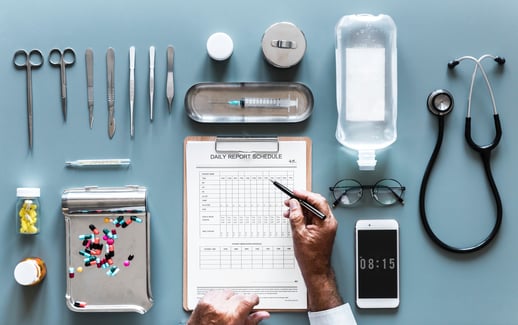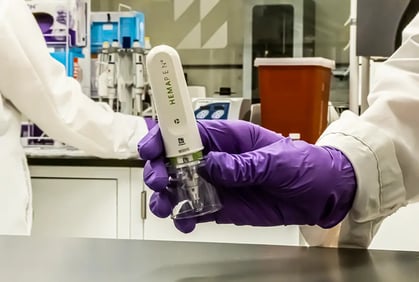Share this
precision medicine is advancing with microsampling
by Neoteryx Microsampling on Nov 12, 2018 4:49:00 AM
 In recent years, precision medicine has influenced interesting trends in the development of devices for collecting biological fluids for bioanalysis. One important trend is the rise of microsampling, which has spurred such developments as remote and home blood collection.
In recent years, precision medicine has influenced interesting trends in the development of devices for collecting biological fluids for bioanalysis. One important trend is the rise of microsampling, which has spurred such developments as remote and home blood collection.
Microsampling procedures using portable microsampling devices and home sample collection kits do not typically require patients to travel to clinics or labs for blood sampling.
Remote specimen collection is helping to drive precision medicine forward.
Regular specimen collection for patient monitoring is necessary in the management of some diseases, such as heart disease or diabetes. Differences in symptoms may be influenced by variables such as patients’ DNA (hereditary genetic conditions) or their lifestyle and environments. For more effective treatment, medical practitioners need to understand these individual differences.
Here are a few of the many reasons why remote specimen collection and microsampling is believed to make great changes in the future of precision healthcare.
Cost-Effectiveness of Microsampling and Precision Medicine
The rise of precision medicine may lead to a long-term reduction in the costs of many treatments. As medicine gets smarter, money will be allocated toward targeted, high-priority needs. New procedures will do away with much trial and error, with a greater focus on more effective treatment personalized to each individual for improved results. Expect investing interests to increase as biopharmaceutical and pharmaceutical companies develop more advanced interventions.
Improved Specimen Sampling Means Improved Treatments
Precision medicine is aimed at improving the health conditions of patients and extending life expectancy. This is a result of more effective treatments for chronic diseases. Doctors can now do a better job of tracking the history and progress of a patient's condition to determine their genetic makeup and how they respond to treatments over time. Remote microsampling devices can be used by patients to collect blood samples in their home at different time points. The blood microsamples can be analyzed in the lab to help determine if prescribed medications are effective.
Care providers can also use remote microsampling devices for remote specimen collection to track the impact of unhealthy lifestyle behaviors, such as alcohol consumption. Alcohol biomarkers in blood can reveal the level of alcohol intake. This data can be used to determine the best lifestyle interventions or treatment procedures for particular patients.
Microsampling: A critical tool for precision medicine?
Precision medicine is the future of healthcare. However, it cannot be as effective without remote specimen collection with precision microsampling in play. Precise treatment regimens require frequent specimen sampling or blood draws from a patient at different time points throughout their treatment. The most convenient way to do this is to enable patients at home to self-collect their samples using remote microsampling tools.
 One microsampling tool available on the market is the hemaPEN®, a precision DBS microsampling device that collects 4 volumetrically identical capillary samples from a single finger-stick. When the end-user clicks the hemaPEN shut after sampling, the device transfers those 4 samples onto 4 DBS filter papers that are locked inside until lab processing.
One microsampling tool available on the market is the hemaPEN®, a precision DBS microsampling device that collects 4 volumetrically identical capillary samples from a single finger-stick. When the end-user clicks the hemaPEN shut after sampling, the device transfers those 4 samples onto 4 DBS filter papers that are locked inside until lab processing.
Another available microsampling tool is the Mitra® device based on VAMS® technology. Like the hemaPEN, this device is portable and minimally invasive.
 The Mitra relies on a quick finger-stick with a lancet method. The end-user can absorb a few drops of blood from their fingertip onto the absorbent sponge tips on the end of each microsampler in the device. Mitra devices are available with different tip volumes to fit different projects and budgets, including 10, 20, & 30 µL volume VAMS tips.
The Mitra relies on a quick finger-stick with a lancet method. The end-user can absorb a few drops of blood from their fingertip onto the absorbent sponge tips on the end of each microsampler in the device. Mitra devices are available with different tip volumes to fit different projects and budgets, including 10, 20, & 30 µL volume VAMS tips.
The remote microsampling approach helps to ensure the patient’s comfort, while also delivering high-quality samples for reliable analysis in precision medicine. In Europe and the United Kingdom, many practitioners are already using remote specimen collection with these remote microsampling devices for therapeutic drug monitoring of patients with organ transplants or chronic conditions. The difference is already apparent. Learn more here!

Share this
- Microsampling (206)
- Research, Remote Research (119)
- Venipuncture Alternative (105)
- Clinical Trials, Clinical Research (83)
- Mitra® Device (73)
- Therapeutic Drug Monitoring, TDM (51)
- Dried Blood Spot, DBS (39)
- Biomonitoring, Health, Wellness (30)
- Infectious Disease, Vaccines, COVID-19 (24)
- Blood Microsampling, Serology (23)
- Omics, Multi-Omics (21)
- Decentralized Clinical Trial (DCT) (20)
- Specimen Collection (18)
- Toxicology, Doping, Drug/Alcohol Monitoring, PEth (17)
- Skin Microsampling, Microbiopsy (14)
- hemaPEN® Device (13)
- Preclinical Research, Animal Studies (12)
- Pharmaceuticals, Drug Development (9)
- Harpera Device (7)
- Industry News, Microsampling News (5)
- Antibodies, MAbs (3)
- Company Press Release, Product Press Release (3)
- Environmental Toxins, Exposures (1)
- July 2025 (1)
- May 2025 (1)
- April 2025 (2)
- December 2024 (2)
- November 2024 (1)
- October 2024 (3)
- September 2024 (1)
- June 2024 (1)
- May 2024 (1)
- April 2024 (4)
- March 2024 (1)
- February 2024 (2)
- January 2024 (4)
- December 2023 (3)
- November 2023 (3)
- October 2023 (3)
- September 2023 (3)
- July 2023 (3)
- June 2023 (2)
- April 2023 (2)
- March 2023 (2)
- February 2023 (2)
- January 2023 (3)
- December 2022 (2)
- November 2022 (3)
- October 2022 (4)
- September 2022 (3)
- August 2022 (5)
- July 2022 (2)
- June 2022 (2)
- May 2022 (4)
- April 2022 (3)
- March 2022 (3)
- February 2022 (4)
- January 2022 (5)
- December 2021 (3)
- November 2021 (5)
- October 2021 (3)
- September 2021 (3)
- August 2021 (4)
- July 2021 (4)
- June 2021 (4)
- May 2021 (4)
- April 2021 (3)
- March 2021 (5)
- February 2021 (4)
- January 2021 (4)
- December 2020 (3)
- November 2020 (5)
- October 2020 (4)
- September 2020 (3)
- August 2020 (3)
- July 2020 (6)
- June 2020 (4)
- May 2020 (4)
- April 2020 (3)
- March 2020 (6)
- February 2020 (3)
- January 2020 (4)
- December 2019 (5)
- November 2019 (4)
- October 2019 (2)
- September 2019 (4)
- August 2019 (4)
- July 2019 (3)
- June 2019 (7)
- May 2019 (6)
- April 2019 (5)
- March 2019 (6)
- February 2019 (5)
- January 2019 (8)
- December 2018 (3)
- November 2018 (4)
- October 2018 (7)
- September 2018 (6)
- August 2018 (5)
- July 2018 (8)
- June 2018 (6)
- May 2018 (5)
- April 2018 (6)
- March 2018 (4)
- February 2018 (6)
- January 2018 (4)
- December 2017 (2)
- November 2017 (3)
- October 2017 (2)
- September 2017 (4)
- August 2017 (2)
- July 2017 (4)
- June 2017 (5)
- May 2017 (6)
- April 2017 (6)
- March 2017 (5)
- February 2017 (4)
- January 2017 (1)
- July 2016 (3)
- May 2016 (1)
- April 2016 (2)


Comments (1)